| Construction Rating: | starstarstarstarstar_border |
| Flight Rating: | starstarstarstarstar_border |
| Overall Rating: | starstarstarstarstar_border |
| Diameter: | 1.64 inches |
| Length: | 27.48 inches |
| Manufacturer: | FlisKits  |
| Skill Level: | 2 |
| Style: | Scale |

Brief:
Sport-scale version of the Thunderbird Anti-aircraft missile with a single 18mm motor mount
Construction:
The parts list:
- 1 BT-60 body tube
- 4 BT-20 booster tubes
- 1 BT-60 balsa nosecone
- 1 18mm motor mount tube
- 2 sheets of 1/8" balsa fin stock
- 1 small sheet of 1/16" balsa fin stock
- 16" chute and ample elastic shock cord
- Kevlarleader
- 1/8" launch lug
- rings and engine block for 18mm
- screw eye for nose cone
- fin pattern sheet and cardstock for the tail cone, booster nose cones, and booster motor cones
- templates includes spare parts
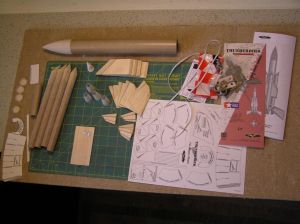
The instructions are very well done. I found no problems at all with them. I jumped around, as I always do but following them in order would work just fine.
I deviated a bit from the instructions because I assembled and painted the boosters separately from the sustainer. The build was very challenging, yet the instructions take you through each step and even offer alternative steps to take your build up a notch or two.
This is one of those rockets I couldn't stop working on till the end. I like the complex looking rockets that come with detailed, easy to follow instructions.
The inverted cone inside the tail cone makes the rocket that much more interesting!
Sanding the fins took a while. I used masking tape to demarcate the bevels while shaping. This is essential, you can't do it by eye... I used Elmer's Fill 'n' Finish to fill the grain. One trick I tried was to tape off all the bevels, applied the filler and sanded with a sanding stick, then I removed the tape from the beveled surfaces and taped off the flat surface of the fin, more filler and sanded those areas. This left a nice sharp faceted and filled balsa fin.
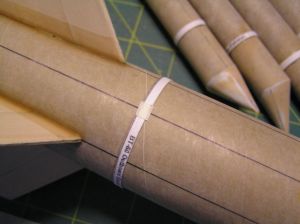
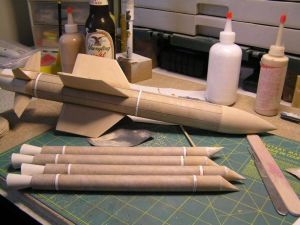
I found the cones were not hard to construct. I pre-curled them then removed the overlap joint and glued it inside the joint. I drizzled thin CA to harden them and used wood glue to attach them with the integral couplers. Once dry, I dabbed wood filler around them and sanded flat with a sanding stick by keeping the stick flat with the OD of the booster tube.
The booster straps are optional and I decided to use them. I used wood glue so they make a solid attachment with the sustainer straps. I taped off the booster/sustainer attachment points before painting. I used medium CA to tack the boosters on then applied wood glue fillets with a bamboo skewer. I think the straps add a lot to the overall look of the model.
The aft shrouds coupled together perfectly, I was surprised at how well they fit together. I had a little issue with the outside tail-shroud being a little loose where it met the body tube so I reduced the wide end by cutting a angled sliver from the wrap. This kept the smaller end to size. I only changed the size by maybe 2-3%, very little.
One reason I built the boosters separate was I thought the fins may be hard to fillet with the tubes in the way but after building the model, I see enough room to do this after the boosters are installed.

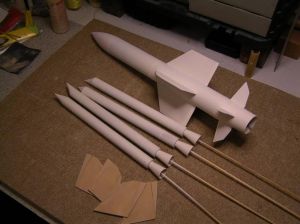
All things considered, the most time consuming part is the fin beveling. It was not really hard to do, just took some patience. I did a lot of marking and checking as I filled and sanded them. They don't need to be perfect to look good on the launch pad so they should only be as much work as the builder wants to invest in that aspect. I'm just a little more detail obsessive than I should be in some cases
I would liked to have had a little harder balsa for the fin stock. It was easy to splinter when trying to sand the bevels so I left the edges a little fat so they might hold up better. The soft balsa is easy to sand so it's not a big problem. Also, I started out with 120 grit so in defense of the balsa, 220 grit or higher might have been a better choice to rough shape the bevels.
I made one mod. On the inside small end of the booster motor shrouds, I installed a round balsa block (1/8" thick) so I had a balsa to balsa joint when gluing them on. I used thin CA to harden the paper as well. This is purely my own idea as the stock method should work fine. That's the obsessive me coming out again
the best advice for building the model is to check measurements, alignment, and part fit before committing to glue. Of course, this is good advice for any model.
Finishing:
If a person prefers to fill the spirals, do it beforehand on this one. It will be much harder to do later.
The model was painted a fictional scheme with Createx airbrush colors shot through a Paasche H airbrush. I mixed up some military looking colors from what I had on hand.
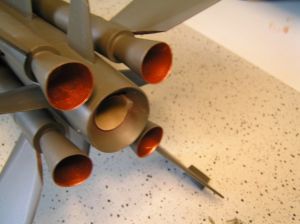
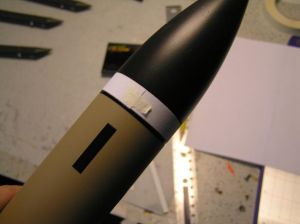
The metallic copper is Anita's brand craft paint from one of the major craft stores. I just brushed it on.
The model is not that hard to build or paint if it's broken down into sections. I put tape over the glue joints between the boosters and sustainer than glued them together after painting.
The model does not include decals as the real missile is usually found in an overall green color. I added a few small pieces of black vinyl just to jazz it up a bit. I docked 1/2 construction point because I feel the model is deserving of a higher skill level rating than the stated 2.5 for the model. However, I also believe that a very nice and easier model can still be made without beveling the fins and adding the optional details.
Construction Rating: 4 out of 5
Flight:
The recommended motors are B6-4 and C6-5. I prepped the model with 4 wads of Estes wadding. I flew the model from a 1/8" rod Estes pad on the recommended C6-5. The model put in a very nice flight. There was some wind yet the rocket stayed on a straight course.
Recovery:
the model includes a Kevlar leader connecting to an elastic line. The length was enough to prevent the nosecone from snapping back after deployment
Ejection was very close to apogee. Sadly, I could not get a launch picture as I was launching the model myself.
After landing on its side, the stiff breeze on the field caused the model to roll over several times. This resulted in three of the boosters tearing clean from the optional paper bands. The damage was actually quite minimal. As I approached the rocket, it looked like the model had strangely jettisoned it's boosters after landing as they lay there surrounding the rocket.
I plan to make an easy fix by gluing the boosters directly to the sustainer, which is also suggested in the instructions, and wrapping the bands around the tubes to give the same illusion (a great idea posted by one of the members of the Rocketry Forum).
Flight Rating: 4 out of 5
Summary:
PROs: very cool scale-like model that is both challenging and rewarding to fly.
CONs: lots fins that can be easily damaged on hard landings. However, this is the nature of many unusual scale missiles, and this model turns out more robust that it might appear at first look.
Overall Rating: 4 out of 5
 |
 |
Flights
Sponsored Ads
 |
 |











